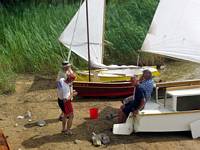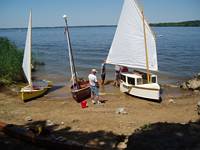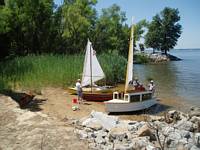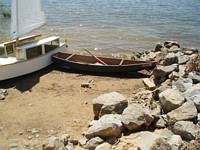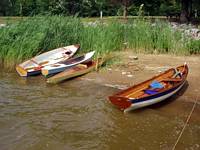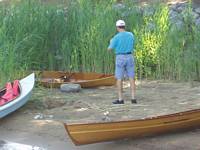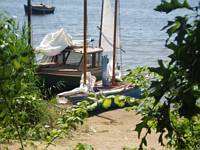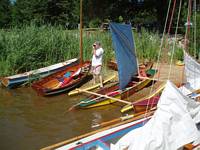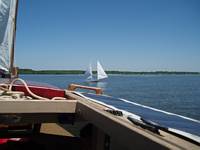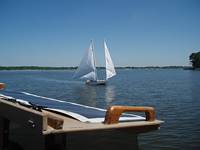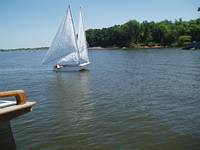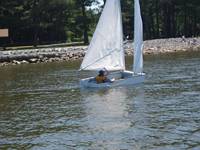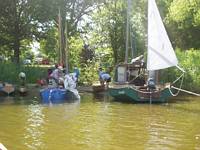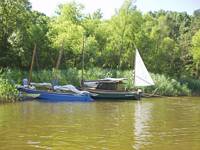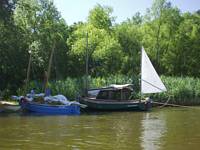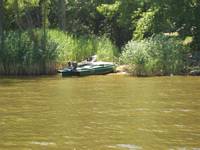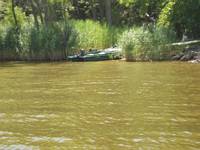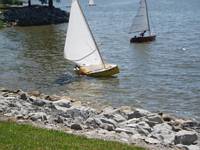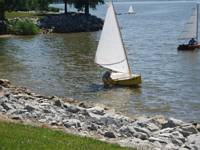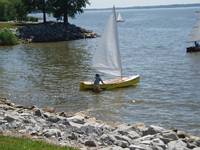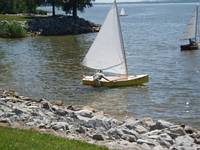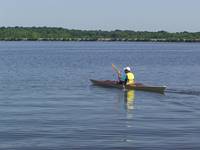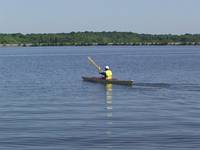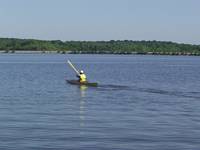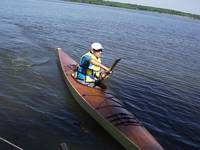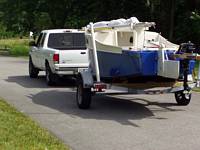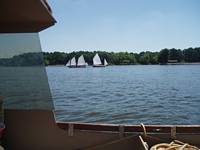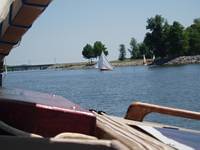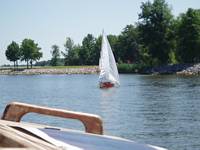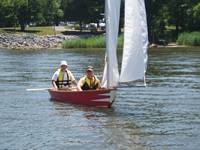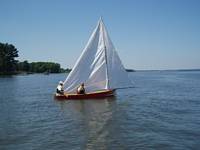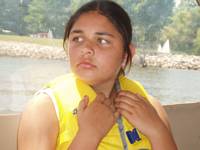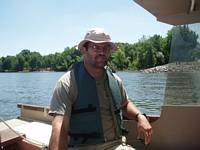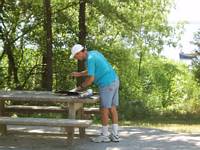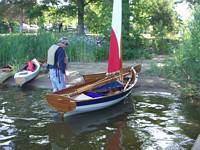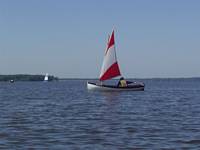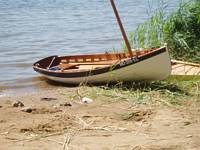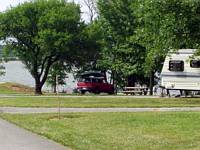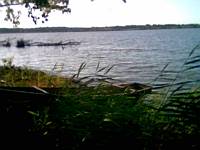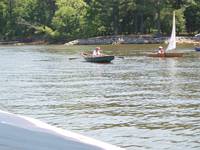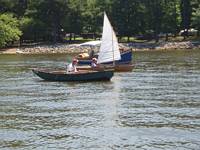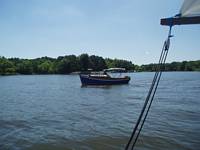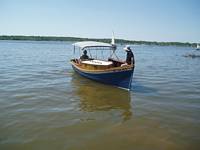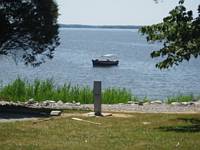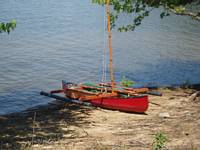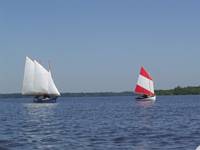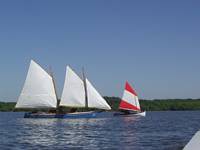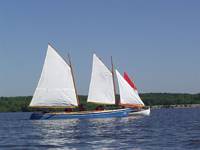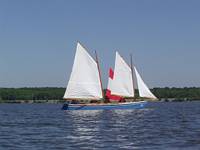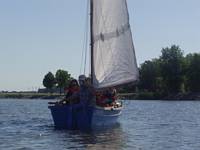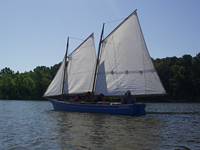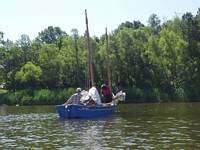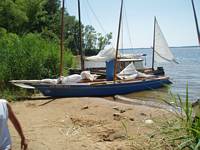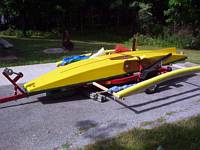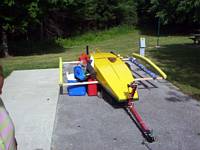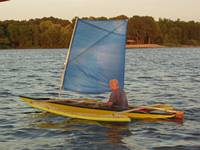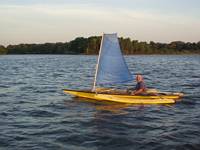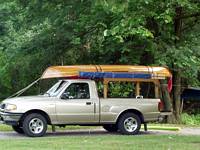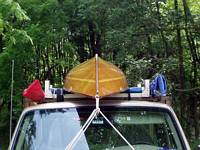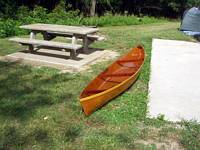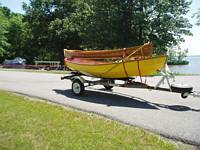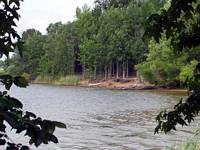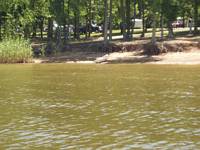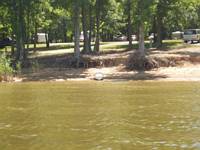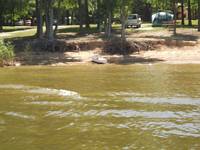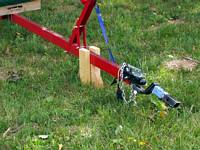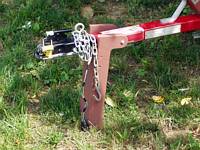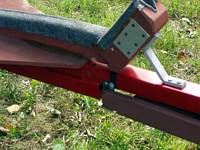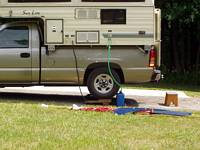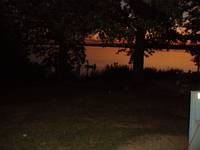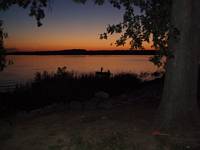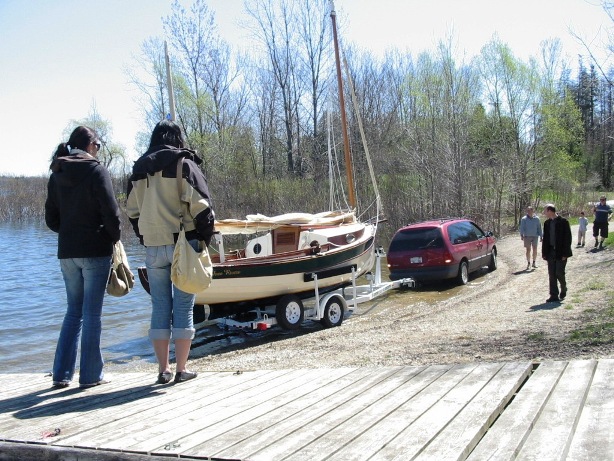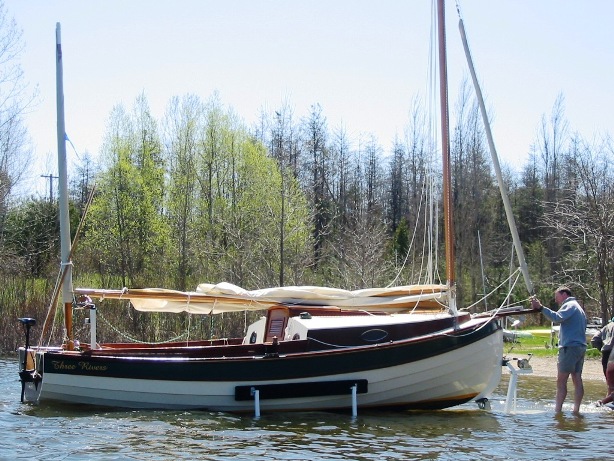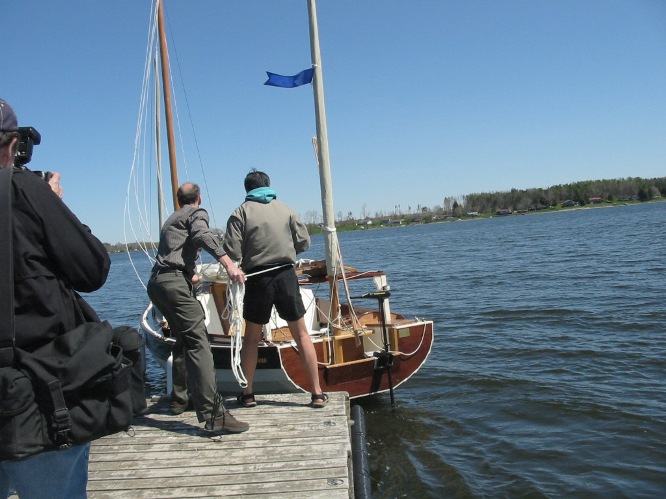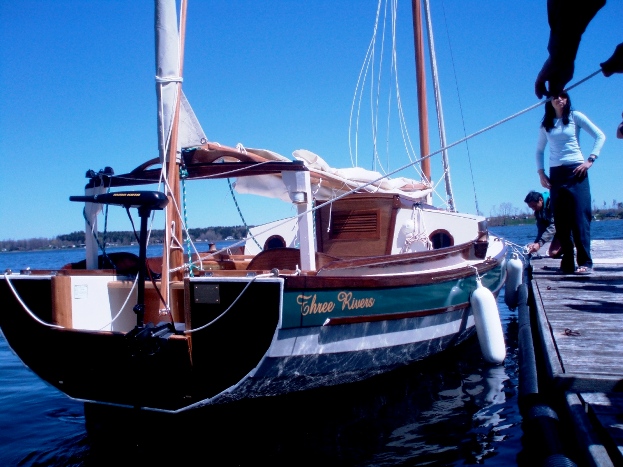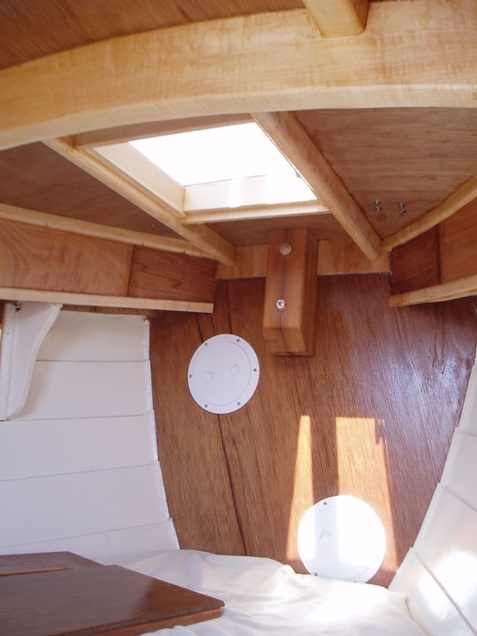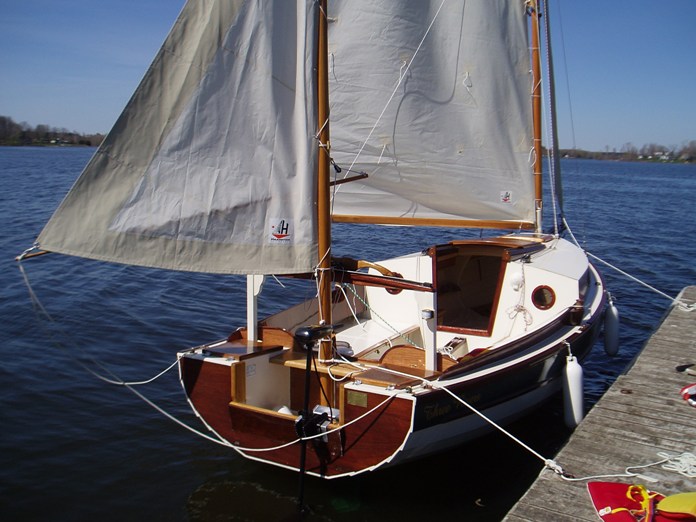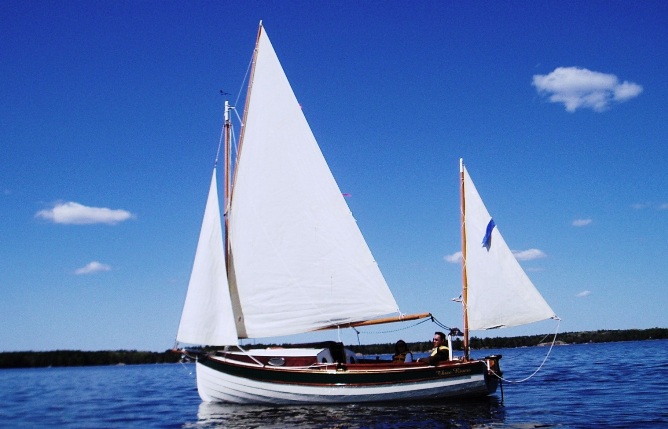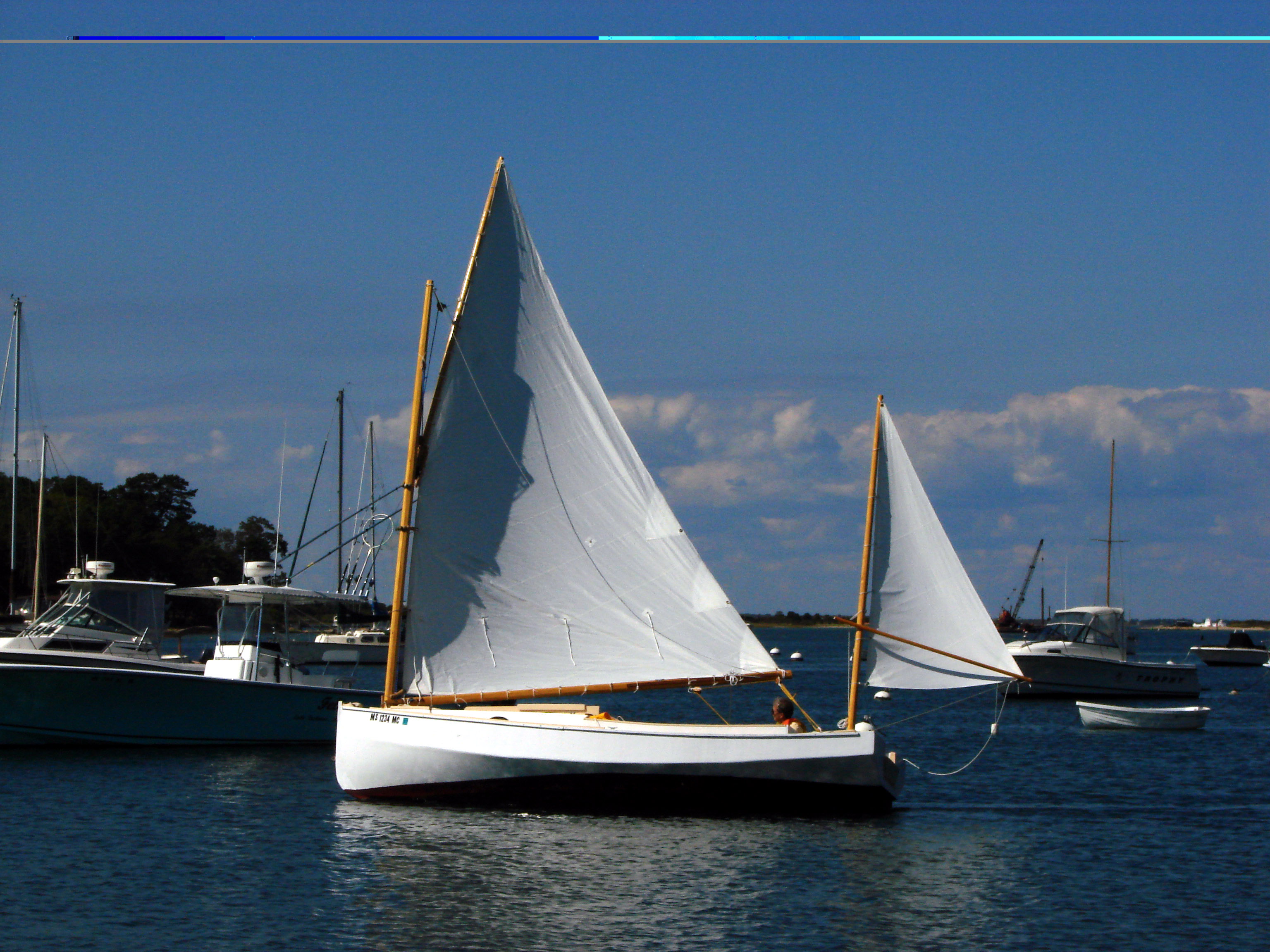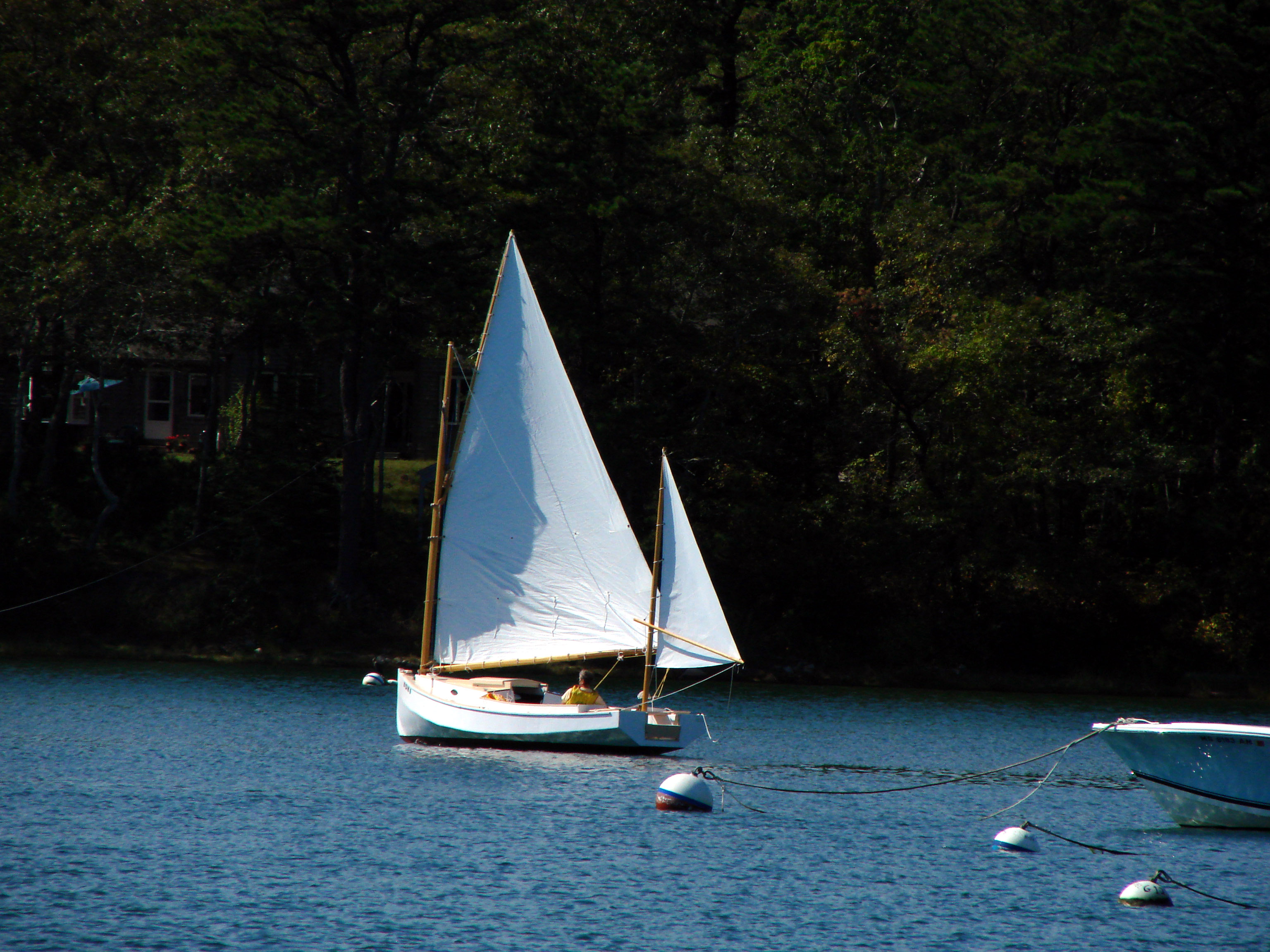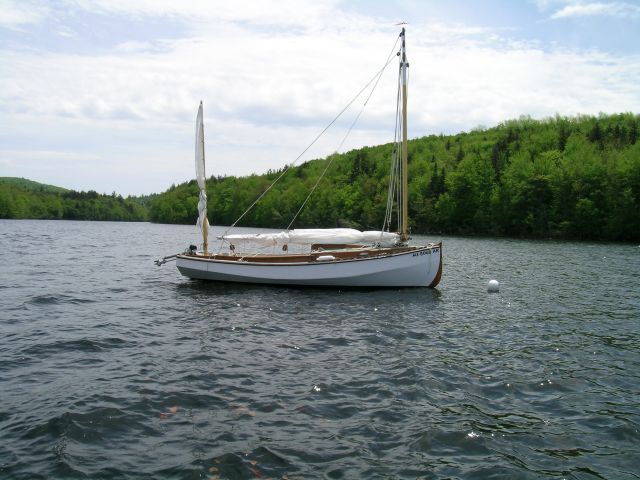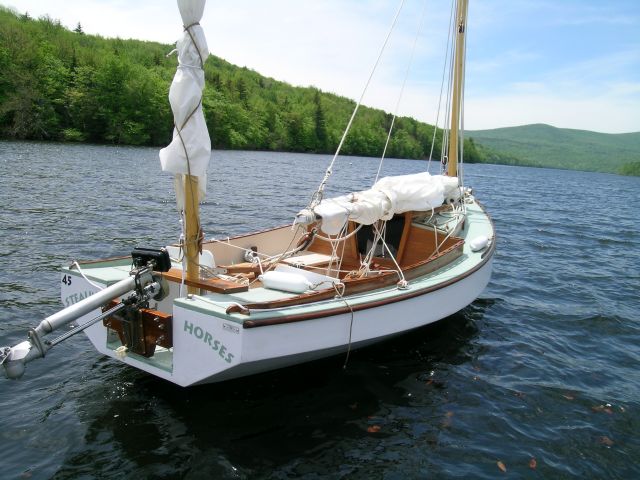Rend Lake 2007 – Richard Spelling
For this messabout I get to try out my new (well, new to me) truck.
I have been in need of a bigger truck for a long time, the Toyota Tacoma, while a nice little pickup, is way too little to tow my boat on a regular basis. And there is no way four people can fit comfortably in it.
Bought a replacement, on eBay of course. Paid 2/3 of Blue Book for it. It’s a 1999 Dodge Ram 3/4 ton with the turbo diesel. BIG truck, big engine. It tows my 3500lb boat and trailer like there is nothing connected to the back of the truck. Even up the hills that call themselves mountains in Missouri, I can fly past the semi trucks in the “slow” lane doing 70mph uphill into a head wind.
And it’s big enough to haul everybody in the cab. I like it. It suits me.
This year my wife Pat decided to rent a room in the Lodge at Gun Creek, so she wouldn’t have to do the tent thing, and so she would have a place close to take a shower.
Sometimes at a messabout you get rained out. Sometime it’s to hot, sometimes it’s rainy and cold. Sometimes the wind blows so hard you can’t get on the water. Other times it doesn’t blow at all. I have to say, out of all of messabouts I’ve been to; the weather at this one was absolutely perfect. It was so nice, in fact, that Pat canceled her second night at the Lodge and spent the night on the boat with me.Of course, when we arrive, we discover that the park service has put in a nice new bathroom with many showers.
Friday, the first day of the messabout, there was perfect wind for sailing. Got out some, but as I pointed out several times to people who said “you are missing all the good sailing wind”, I can go sailing anytime, I come here to visit with other boat builders. Which is an interesting thing, as, generally speaking, homemade boat builders are an introverted lot, and not the most sociable people around. So a messabout is, in essence, a social event for anti-social people. Not an unfair assessment of a bunch of people who make their own boats, and spend more than a good used “production” boat would cost doing so.
There were lots of boats there this year, as you can see from the pictures below. Lots of good photos this year too, I’ve already updated my slide show screen saver at work. Even without photo shop, some of the pictures below turned out really nice.
I have done my best to match up boats and builders, but if anyone sees one I have misidentified let me know and I’ll fix it.
Several shots of the two beaches where we pulled our boats up. Max taking a picture of Larry Appelbaum’s Swamp Yankee Canoe.
David “Polytarp Sails” Gray (PD Racer with “biplane” rig)
Some green catboat or something anchored next a schooner.
Mike Zenker (Campanoe)
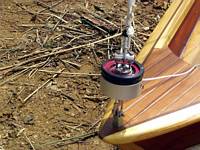
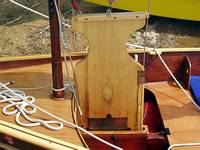
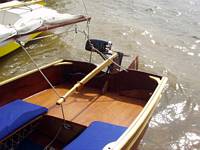
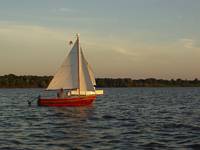 Windigo 11, an original design by Dave Seaberg. Lot’s of interesting features on this boat. On the left note the scratch built roller reefing system. Next is the dagger board, complete with dumpster scrounged steel plate for anti-floatation weight. Middle right is a nice shot of the sheeting arrangement. Far right is a shot of the boat sailing; if you click on the image you will be able to see the anti-turtle ball on the top of the mast.
Windigo 11, an original design by Dave Seaberg. Lot’s of interesting features on this boat. On the left note the scratch built roller reefing system. Next is the dagger board, complete with dumpster scrounged steel plate for anti-floatation weight. Middle right is a nice shot of the sheeting arrangement. Far right is a shot of the boat sailing; if you click on the image you will be able to see the anti-turtle ball on the top of the mast.
Mounting procedures. This is Tom Hamernik in his Michalak Mixer design
Max Wawrzyniak and his interpretation of a CLC kayak. Note the serious look on his face in the far right photo.
Jim Tucker, cat-yawl Normsboat with sprit-boom sails. Complete with painters poles for sprits
.Damn, he has more sail up than I have on my Chebacco. This is Philip Frohne in an Uncle Johns Skiff.
My daughter looking bored, couple shots of me, and the cook organizing the potluck.
Paul Ellifrit’s Oughtred Acorn lapstake. This one is so well built and so pretty I would be afraid to take it sailing, for fear of marring the spotless finish!
Several shots of Jim Michalak’s Roar II rowboat.
The intrepid Skiff America built by Kilburn Adams.
Bishop Curran sailing canoe. PVC pipes for amas.
Initiate passing manoeuvres.
Rob Rohde-Szudy’s Light Schooner manoeuvring for a landing.
Steve Lewis’ Scout Canoe. Kewl toy. I especially like the choice of floatation material for the amas. Floaties, no less.
Steve Lansdowne’s Wee Rob sailing canoe, Larry Appelbaum’s Swamp Yankee Canoe, and Mike & Linda Walsh (Cartopper & Wee lassie stripper canoe)
Lonely Toto on the beach. Belonging to Phillip Reed I believe.
Sometimes the most interesting thing about these events is not even the boats, it’s how other folks have solved common problems.
Sunset and a pole punt.
***
Wayward Lass’ First Sail of 2007! – Jamie Orr
I’d been waiting since the beginning of October to get away for a few days in Wayward Lass, but a series of events kept me home. But I had enough unused holiday time for a good break over Christmas so I decided to go as soon as the holiday celebrations were over.
Wednesday, January 3rd, found Wayward Lass and I launching at Tulista Park in Sidney (on Vancouver Island). My plans were to sail across Haro Strait to the San Juan Islands if things looked good, otherwise to poke around the Canadian gulf islands until it was time to come home on Saturday. The light wind was just enough to carry us away from the dock so we moved very slowly at first, but the breeze steadily picked up and soon carried us to the end of Sidney Spit, about three nautical miles away. From there, it was seven miles of more or less exposed water to Roche Harbor on San Juan Island. The forecast said I could expect moderate southwest winds, (15 to 20 knots) which meant I would have them on my starboard quarter – too good to pass up!
Once we were in the open, the wind rose to better than 15 knots (estimated) and with Spieden Channel (just outside Roche Harbor) lined up over the bow, Wayward Lass was soon making 6.5 knots on a broad reach. We might have picked up a knot from the tide, but otherwise it was all wind power. I could see one sail far to the north, but except for that I had the whole ocean to myself. The wind kept its promise, and a little over an hour later I was in Spieden Channel, preparing to beat through the northwest entrance to Roche Harbor. I was delayed, however, by a big aluminum, RIB-like boat that came speeding up behind, flashing a pair of blue lights to demand my attention.
I slowed Wayward Lass by letting the mainsail run free as the coxswain on the other boat throttled back, leaving our two very different boats bobbing side by side. The young fellow on the bow (why do they all look so young these days?) asked if I’d ever been boarded by the Coast Guard. I said no, but that he was welcome to come aboard. He said he would, but offered to wait until I was in more sheltered water. The wind was dropping though, and getting in was going to take a while, so we agreed we might as well get it done. There was more room to drift around out there anyway. I parked Wayward Lass by centering the mizzen while leaving the mainsheet loose, so she rode head to wind while drifting slowly backwards, a couple of the Coast Guard crew stepped across.
They were very professional and the inspection/interview took less than three minutes, but completing the paperwork took a lot longer! It didn’t help that Wayward Lass is unregistered, unlicensed and has no hull ID number — Canadian law doesn’t require any documentation for a boat (and motor) this size. I’ve never even painted her name on the transom. I’ve never had any problems because of having no documentation — the first time I sailed into a US port (Port Townsend in Washington), US Customs made up a number based on my name and birth date and that has been accepted by US and Canadian Customs ever since. It doesn’t appear anywhere on the boat, though.
I thought the Coasties might have been looking for marijuana, as I understand quite a bit of that enters the US by the San Juans, but they said they were just keeping an eye on who was entering the country. It must have been a pretty slow day for them, as we were the only two boats in sight.
After seven years Wayward Lass is pretty well equipped and we had no problem passing the inspection. I now have a nice yellow boarding form to wave the next time I’m stopped, although I was warned it didn’t guarantee that I wouldn’t be inspected again anyway. I got a kick out of seeing that one of the potential violations was a “manifestly unsafe voyage”. I wonder how they define that one!
Wayward Lass and I eventually entered Roche Harbor around 3:00 pm and found the Customs shack after a short search – they’d moved it, and the docks all looked different in any case. I couldn’t decide if they’d expanded or if the outside docks were just empty for the winter. I phoned Friday Harbor to clear customs since no one was in the shack, then I left again, planning to sail to Jones Island, another 3 miles or so. The wind was very light again, though, and it was getting dark. I realized that I was going to run out of daylight long before I reached Jones, even if I used the motor. I didn’t relish finding the bay and anchoring in the pitch dark, not to mention setting up the boom tent and all, so I turned back for Roche. The trip between Sidney and Roche Harbor had been entirely under sail, but now I furled these and started the motor. Just as well, since a heavy squall caught us on the way back to Roche, if I’d been sailing it would have been all hands to reef. As it was, it gave my new rain gear a thorough workout.
Once back at the dock, I put up the boom tent and prepared a good hot meal. The temperature wasn’t quite freezing, as I recall, but it was pretty cold. I got into my sleeping bag to keep warm as I wrote up the log and read for a while before turnign out the light. Before I went to sleep I listened to the weather forecast for the next two days and decided that I’d better go back to Vancouver Island before the next front arrived, otherwise I could be weather-bound on San Juan Island for several days.
I had arranged to meet a friend in the marina café the next morning, so I didn’t get away until after a leisurely breakfast. When I did set sail, I was still hoping to return to Sidney more or less the same way I’d come – this would have meant travelling slightly north of west. The forecast was for southwest winds, to change northwest later in the morning, so I thought I could sail northwest until the wind changed, then turn southwest for Sidney. At worst I thought I could reach Bedwell Harbour, on South Pender Island, where I could clear Canadian customs.
Expecting brisk winds, I’d put one reef in the mainsail before leaving, but as we were going out the northeast entrance the wind was light so I optimistically shook out the reef. Of course, once I was out in Spieden Channel it started to blow hard, harder than I would have liked even if I’d still been reefed, so I about-turned and shot back into the relative shelter of the harbor. Again I “parked” the boat under the mizzen while I tied in both reefs, watching to make sure we didn’t drift into the docks before I finished. The wind was strong even inside the harbour now, and was blowing from the west rather than the southwest – not good for going to Sidney. Even getting to Bedwell Harbour looked doubtful, and it would certainly have been a hard, wet and uncomfortable sail. Since I was sailing for fun, I decided to go with plan B (or was it C by now?) – to leave Roche Harbor by Mosquito Pass to the south, then carry on southwest to Oak Bay in Victoria. This would be about twelve and a half miles altogether, putting me about 15 miles south of Sidney. The wind would be fair and I would be back on Vancouver Island long before the front arrived.
I found a sheltered spot in Mosquito Pass and anchored while I tidied up the reefs, furled the main (still double-reefed) and put up the jib. The jib doesn’t work well with the main, as I don’t have a bowsprit and there isn’t enough space between the sails, but I thought the jib and mizzen alone would be well suited to the strong wind I’d experienced earlier. When I raised the anchor and started sailing again, however, I got a surprise. The wind was no longer even enough to take us out of Mosquito Pass against a weak tide, and I had to raise the main again, and shake out both reefs. Once we were out, the wind stayed light and Wayward Lass was only moving at about 2 knots. I hugged the shore until a big freighter went past, then turned towards Cadboro Point, at the north end of Oak Bay, just visible in the distance.
As we left the land behind, the wind picked up again, now from the northwest but not as strong as before. I estimated it at about fifteen knots and perfect for a reach to Cadboro Point. I did think briefly of trying to beat back to Sidney, but we were even farther south now, and dead downwind, so I decided that would be a mug’s game. Instead, I enjoyed a fast return trip across Haro Strait, touching 7 knots when the tide turned and with the mainsail pulling like a train. It didn’t take long at that rate, but once behind Cadboro Point we were out of the main force of the wind and had no trouble sailing right in to the gas dock where the Customs phone is located. With that, Wayward Lass and I had completed another voyage, dock-to-dock, under sail. That and $2 will get you a cup of coffee, but so what –I do this for fun and I get a charge out of not using the motor. I paid for a night’s moorage, buttoned up Wayward Lass and called Maureen to come and pick me up. It’s a pretty nice cruise that lets you sleep in your own bed!
I had decided to cut my sailing holiday short, but I still had to get the boat back to Sidney, some 15 miles north. Friday’s forecast was for southeast winds, 15 to 20 knots, rising to 30 knots – the expected front was arriving. I could have brought the trailer to Oak Bay instead, but the public ramp has no real dock, only a sloping concrete pier disappearing into the water. The ramp is also wide open to the southeast so I felt that it would be a poor choice. Once I’d decided to go to Sidney, I had another decision to make. I could leave early and put up with the waves caused by the wind blowing against the tide, or I could wait for the tide to change but might then have to deal with 30 knot winds. I chose the first option leaving early.
Although I expected it to be fairly strong, the wind would be behind me. I used the motor to get clear of the marina, then raised the sails with a single reef. Getting around Cadboro Point was a close reach, and I took some spray before I was clear. The tide tables said the tide was running at 3 knots against me, but I stayed out of the worst of it by avoiding the roughest water, and got through the entrance okay. As I turned north, the GPS was showing 3.5 to 4 knots — the wind was about 15 knots, I think, and one reef was just about right.
Outside Oak Bay, there was a constant parade of big waves, or swells, coming with the wind on my starboard quarter. These had built up over 30 odd miles of open sea, and now were piling up as they came into shallower water. As well, the tide was pushing in the opposite direction, making the waves even steeper. I was more than a little nervous sailing over these, the motion felt like a roller coaster going out of control. Wayward Lass did a wonderful job, however, although her head swung around as the waves picked her up and played with her, that stubby winged rudder never lost its bite. Luckily our course meant the waves passed under us at an angle, otherwise we would have had to tack downwind to avoid ramming the bow into the wave ahead.
I had the centreboard down to help with the steering, but as we surfed down the waves, it was making a loud thrumming noise, and I was worried about the strain it was creating as we dashed along. Rather than risk breaking anything, I pulled it up and found it didn’t make a lot of difference to the steering – it might even have been easier with the board up. One thing was certain, though – it was a whole lot quieter and less stressful for both Wayward Lass and her skipper!
Looking at the chart now, I see this lasted for close to five miles, or about an hour – it seemed a lot longer. Holding a steady course was further complicated by the unusual number of logs and chunks floating around. The tides had been high (the full moon was just past) so a lot of wood must have floated off the beaches – this is the main hazard on the BC coast and requires a good lookout.
We had been doing over 5 knots over the ground since Cadboro Point, more or less due north, and I wanted to pass just west of the Zero Rock beacon. I thought I could see it, but wanted to be sure it wasn’t Little Zero Rock instead, which is further west and is surrounded by other, less visible rocks. One of the meridians on the chart ran right through Little Zero, giving me its longitude, and the GPS confirmed that I was well east of it. Quick and dirty navigation, but very useful when you don’t have a hand to spare.
Although the swells were gradually lessening in size and frequency, every so often a set of three big ones would roll through, just to keep the adrenalin flowing. (Adrenalin is not much use when you’re sailing. It acts as a super fuel for fight or flight, but the sailor can’t do either, he (or she) has to stay put and steer. Intravenous Valium would be far more use!) As D’Arcy Island came abeam, however, roughly half way to Sidney, both the sea and I were calm enough that I could pour a mug of tea to restore my sagging morale.
James and Sidney Islands were still between Wayward Lass and Sidney. Since the southeast wind picks up speed as it funnels between these islands, I decided I would go between James Island and Vancouver Island instead. As I neared the channel, I saw the only other boat I saw that day, a big skiff close to the Vancouver Island shore, going into the wind through clouds of spray. Whether by accident or design, they had timed it nicely, the tide had just turned and the sea was flattening out now that wind and water were moving together.
Going inside James as we were heading would have meant sailing by the lee, with the boom on the same side as the wind. This is never a good idea as an unintentional gybe can result. I didn’t want to gybe intentionally either, so I went the long way round, turning into the wind, tacking through it then turning downwind again. This put the wind on the other, safer, side of the sail. As we passed James Island the wind was strong but steady and the sea fairly flat, giving us the fastest sailing we had, about 7.5 knots and touching 8 once with a little help from the young flood. It had also been raining hard for some time now, but as we were running before it and my new foul weather gear is so much better than the old stuff, I was still warm and dry. Money well spent!
Once through the narrow bit I tacked the long way round again to reach in behind James, where I planned to heave to and drift while I ate my sandwiches. Unfortunately the bigger winds suddenly arrived, so I carried on instead for the Tulista Park ramp, now only a couple of miles away. When there was only about a mile left I turned into the wind again, centred the mizzen and rudder, dropped the centerboard and let the mainsheet loose. Although the wind was really starting to howl, Wayward lass stayed head to wind very nicely. I released the tension on the reef lines (to take the strain off the fabric), furled the main first, then the mizzen before starting Honda.
The breakwater only partially protects the dock from a southeaster and I didn’t want to try landing under sail then unless forced to. Even with the motor I didn’t want to make a downwind landing. As we came in I turned mostly into the wind but kept it on the port side of the bow so it pushed us sideways towards the dock while the motor kept us from blowing backwards on to the shore. It was sort of like ferrying a canoe across a river, but using wind instead of current to move sideways. The idea was sound, but on the first attempt I straightened out too early and the wind caught the starboard bow, pushing us away from the dock. On the second try I got it right and was able to step off with the mooring lines. I had to let the stern one go, though, because of the wind pushing on Wayward Lass and a very slippery dock (the sections were bucking in the waves too). I made the bow fast then went back on board to use the motor to bring in the stern. A fisheries officer came down and took my stern line but it was still raining hard and he left before I could recruit him to help get the boat on her trailer! It was good of him to come down in the rain at all.
The recovery was easier than I expected. A long line from the bow, led outside around the stern to the dock then to the after cleat, let me turn Wayward Lass around (actually the wind turned her but the line let me control her). Then, with the trailer backed in just far enough for the keel to land on the rear roller without floating over it, I walked the boat onto the trailer as if I was lining a canoe on the river. Some quick work on the winch and the excitement was all over. (What’s all that canoe stuff – I thought this was a sailing story!)
By the time everything was packed up and ready to travel, I guessed that the wind was doing all of the 30 knots that were forecast, but I no longer cared — I was feeling pretty cocky about how it had all turned out.
I didn’t spend any time relaxing at anchor in quiet coves, the way I’d pictured it, but except for that hour or so in the big waves, I’d had a great time. Even the waves were of value, letting Wayward Lass remind me how well she takes care or herself and her skipper.
Chebaccos rule!
***
Launch of “Three Rivers” – Ben Ho
The Chebcaao Three Rivers was launched on a cool but sunny Sunday with much
fanfare, under a beautiful sky with a light breeze. The local newspaper even sent a crew out to report on the story (building a 20 footer in one’s garage, in landlocked Waterloo is newsworthy!).
Lots of spectators providing guidance for backing the trailer…
Everything went quite well. I was relieved that the trailer launching & recovery was fairly straight forward, as the boat ramp at our sailing club has a very shallow gradient limited by the shore line. Prior to the launch I had taken the boat and trailer through a weight station at the local dump. The total weight comes to 2200 lb. The heavy-duty weighs 700 lbs including the spare tire, so the boat weighs at 1500 lb, about right, I think, given the 250 lb of marine batteries I installed for running the electric motor.
There she goes, floating off the trailer.
Now moving the boat to the leeward side of the dock to make it easier to set sails. She wants to take off! With a cross wind of about 5 knots, the boat takes a surprising amount of effort to hold on to with the bow/stern lines. My reference is my 17 ft Marsh Hen, which has a fairly high side for its length, and the Hen takes much less effort. Maybe I do need a crew…
Safely tied down….
The V-berth has a comfortable foam mattress. The ‘skylight’ hatch makes the cabin bright and cozy. One can rest down here after a hard day of sailing, read a book, take a nap…
The wind died (that was when the following sailing photo was taken), and we puttered around with the electric motor, sometimes with a full load of spectators. I like the motor! Nice and quiet, just turn the handle and it goes. The rudder is pleasantly responsive with a very tight turning radius. After a while the wind picked back up to 10 kts. She sailed well in this wind, and is extremely stable (again with my 17 ft Hen as reference). Response is slower than the Hen, which can be expected given two times the weight. Very sure-footed, comes about with no hesitation. At this wind there’s a slight weather helm, just about right. The mizzen doesn’t seem to do much, but I think I have much to learn yet about trimming the mizzen. I remember that someone commented on the webzine that the Chebacco can keep pace with performance dingies such as Wayfarers. Well, not quite. In light to moderate wind, Wayfarers can literally run circles around Three Rivers. So from that perspective I am somewhat disappointed. The raising/lower of the gaff takes more effort than I thought. Also, the gaff jaw rubs hard against the mast such that several spots were stripped bare of varnish, even though the jaw is covered with leather. I think I need to sheath the mast section with a piece of SS sheet. Does anyone else have this problem??
There are still a hundred other small things that need to be worked on, such as where to hang the fenders so they don’t destroy the rub rail….but overall I am quite happy so far, and am looking forward to taking the boat to some faraway lakes and do some serious gungholing…
Cheers
Ben
May 2007
***
A new sheet ply Chebacco – Marston Clough, Vineyard Haven MA, cloughm@hotmail.com
Hi Richard
My Chebacco, first launched briefly Sept 05 was used last season here on Martha’s Vineyard. Have not yet bought motor so haven’t ventured out of protected harbor, due to strong tides which require planning. I went out only once and was not able to buck the tide in light winds.
When building I moved the mast forward as much as I could, which was maybe a foot; the base of the mast is right where the stem is faired into the keel. I sent you some ugly pictures of the modification of this last year at some point.
The finish of my boat is “workboat”, at best, but I did make everything including the mast and spars (with some help) and sail (Sailrite) and looks good from a distance.
There is still weather helm, eased by letting the mizzen off the wind. In fact the mizzen is very important in steering- if too tight in light winds, the boat has difficulty coming about. Steering upwind is likewise controlled by sheeting the mizzen more tightly.
A friend took a couple photos when I was not looking.
***
Off topic: Admiral Dingy Attacked by Vampires – Admiral Dingy
THE CIRCUMNAVATION OF LAKE SABINE!
The first time it happened was really a bad experience but nothing compared to the second time. They came upon me in Biblical proportions, the Creatures from Hell. I had just dropped anchor and was readying the Cruise Ship Dinghy and myself for a desired rest after our day of rowing. The surroundings were perfect, dusk would be coming soon, there were birds all around and Mullets were jumping. How pleasant to reflect back on the day’s events and the joys of the cruising life! Ah, the cruising sailor and his dream! The thunder and the threatening black clouds are rolling in. Now the extreme downpour of heavy rain and wind is over 50 knots. I sit inside of my coffin size ship realizing what a lucky sailor I truly am. Life is good and I love the experience of the storm at a safe anchorage.
Enter the Creatures from Hell and the nightmare begins! As I come out of the hatch to smell the roses and the gentleness of Mother Nature after her violent storm, reality hits me. I take a deep breath and something flies up my nose and all Hell breaks loose. I didn’t even see em coming! Let’s just say that I’m not overly dressed at this instant and while I’m wondering what is in my nose I start to feel something on my body stinging me. Then my brain kicks in and I discover that I’m in deep trouble. Something is attacking me with thousands of painful little bites and the bite sources are all over me. I start slapping them in self-defense and I’m killing ‘em by the hundreds. But killing thousands by the hundreds is not good or fast enough! I take my hand and place it on top of the intruders and rake them over in a killing stroke down the length of my body, removing and killing the attacking monsters. By this time I’m completely out on top of the boat and I dive into the water in an attempt to rid myself of the thousand-fold parasites. I stay under the water for long periods at a time coming up only to breathe; I find the brackish water somewhat soothing from all the bites. The fight is over as long as I’m in the water. Yet I know I cannot not stay in the soothing brackish water all night with the possibility of hypothermia setting in being ever-present.
My plan is to quickly go back aboard ship, climb inside, and close the hatch as fast as possible. After gaining the inside of the boat and slamming the hatch to keep those mean, biting bugs out, I grab a towel for double duty: to dry myself and to kill the enemy. Peace at last! Well, not yet! There are still a threatening amount of mosquitoes left inside. Oh! I happen to have some material (fabric) aboard that happens to be mosquito cloth. I’ll cover up with that and it should keep ‘em off of me.. Good in theory and it works. Well—almost. You see, if it’s draped over me, the mosquitoes can’t bite me unless the cloth is laying on me, directly on my skin. If that’s the case they just drill in and start pumping my blood. Well, I decide to give that a try; I’m desperate and will do anything to rid myself of those ruthless (but obviously not toothless) bugs. Not all the Vampires are on the outside of the cloth, some have manag ed to get inside the cloth and position themselves right next to my skin, and are poised to bite!
WHOOPS! The battle is not over! In fact, I can tell that this is going to be an all-night ordeal. The exposure from the sun and now the attack of the Vampires has left my skin in a burning, inflamed state. It has been hours now and I’m still fighting these blood-sucking Vamps. Sleep has not come my way, fatigue has fallen upon me and cruising is no longer fun. I never experienced this kind of action in the Hollywood jungles. I have now resolved that I will not continue cruising until I’m better outfitted to fight those unwanted visitors of the night. After all, there have been reported cases of West Nile Virus in this part of the world, and with the thousands of blood-sucking Vampires feeding on me; it’s quite possible that I have contracted that dreaded Virus.
So now I cannot help but wonder what symptoms I should be looking for and hope that they don’t surface within me. One thing that I fear most has now come to past. It’s not the monsters of the deep that scare me; nor the mighty beast from the forest. It’s the mosquitoes (or as I call them “vampires”)– that frighten me! If these little and I mean little mosquitoes are so bad, I’d hate to be exposed to what their big counterparts in Southeast Texas can do.. If the little ones bother and plague me so much, imagine what the bugs in the Amazon Rain Forest are capable of doing. I got off easy in this case. They could have been Killer Bees, or even Marabunta Ants that would have eaten my entire body in a matter of minutes. Not to mention those parasites (that I would rather not mention by name or species, and that I am sure that you have heard about) that get inside your body and feed off of your flesh until you die. I wonder how many deaths have been bug-related?
Enough of these tales of woe! Let’s go back to the beginning of the adventure and look at the really great side of the cruising life. The date is 15 August, 2006, and it’s 04:27 hours. This is the first day of cruising around the world in the smallest ship to ever do so. This is also the first cruise for the Cruise Ship Dinghy I will no longer think of her as a working sculpture but a ship of the Oceans and of the world. I will think of her as my safe passage to adventure, education, and the unknown. I have to admit that I have been talking to this Dinghy for more than 32 years now.. It will be a new kind of dialogue as we find our adventure together, circumnavigating Lake Sabine, which amounts to a round-trip distance of 66.5 miles with Toups Marina serving as starting and ending point.
As I cast off from the side of my beloved Neptune’s Castle, my 62-foot sailing ship I come to the realization that I’m leaving my home of more then 20 years. I will be passing on my position as her Captain to Darrelle– Daughter of Dingy– the little girl who once lived aboard her hull and deck. The little girl who played with her ship’s wheel and stood on her salon table and vied for attention at age two.
I’m sincerely wishing that Neptune’s Castle and Darrelle–Daughter of Dingy will have a long and adventuresome marriage together. They are both in their 20’s and have a life of discovery to find. As for me, I’m bound for the Intercoastal Waterways AKA The Ditch to find my adventure. About two miles down stream on Cow Bayou, the little ship cruises by Burton’s Shipyard and I am able to spot its proprietor, Fred getting his crew of yard birds ready to do their duty on repairing the ships in the Yard. I hope that he isn’t looking at the Dinghy too hard, because I just had one my first Dumb Dingy moves: I have managed to run aground on the little point at the shipyard! No big, I’m off and running and I don’t think that he even noticed my Dumb Dinginess.
The bridge is coming up as I thread the needle and row under the bridge. The Dinghy is now in open water with no more overhead obstructions. Now I can rig the mast and sail. After a very good show with my balancing act, it is done and the ship is rigged for running. Not really, just a few probs.with the sail that can’t be fixed at sea. That means no sailing! No prob. I have two 24-volt continuous-run motors. Not really, one is frozen and the other doesn’t have a shear pin, which can be fixed at sea. So I elect to:
, Row, row, row my boat, gently down Sabine—![]()
–Merrily, merrily, merrily, merrily, living out my dream!
Rowing is something that I’ve hardly done with the Cruise Ship Dinghy. After I cut her deck and cabin off, I used to row her and found her to be a slow row. But she ran straight and true with her full keel. She is what she is: a cargo boat designed to carry a load, and now with her high freeboard, she is weighing in at about 2000 pounds and that’s with me in her! Take into consideration that she has her superstructure now and that means more wind obstruction with her higher center of gravity because of the mast, the wind generator and VHF and computer signal antennas. These have contributed to changing her motion on the ocean.
I’m starting to perfect my rowing with this craft, and rowing is something I’ve always loved doing. I started out this morning with a forward push type rowing. Although I do enjoy this rowing style, it is not the fastest. I do find it the most logical, though– and I also find it to be the safest style because I’m facing forward and pushing my one-ton boat forward with 10 foot oars. In short, I can see where I’m going without turning my head. The next style of rowing is standing with my back to where I’m going and pulling the boat forward. Oh, and in all of these rowing styles I will be standing. That’s just the way the Dinghy is set up and I don’t foresee the possibility of me changing it. Besides– I’m looking for a full-body workout. One more style is sculling with one oar at the center of the stern of the Dinghy. Also–I’m using the muscles in quite a different way by simply turning around and rowing backwar ds. So I’m man I’m getting my balance, my form, my rhythm, and style. One thing that’s not included in that workout “package” there yet is my deep, diaphragm-based breathing.
On down Cow Bayou I row, until I float onto a sand bar at the end of the bayou where she meets the ICW. That’s because about 35 or 40 black buzzards gathering in the trees and on the beach are glairing at me. They have my attention and I have theirs. As I look through my bino’s and see the intense, focused look on their faces, I can’t help but wonder what they’re bound to be thinking. Are those birds thinking that I’m carry-on for an afternoon snack? If so I’m dead meat! After all, there a lot more of them than there are of me–! So can you imagine these birds turning into hunters? Shades of The Birds by Alford Hitchcock!
`
Enough of the birds! I have to move on and the ship is hard aground. WHOOPS! I’m off rowing once more! Now the Dinghy is on the Inter-Coastal Waterway (ICW) about another five miles to row and I’ll be settled in for the night. Anchor is set and I’m kicked back! Cool!
Then along the ICW come two of the wild bunch– Will and Willey Toups in one of the strangest boats I’ve ever seen–delivering beer and conversation from Toups Marina. Now this is really too cool! So we enjoy the beer and the converse and then the storm is upon us.
..
DUMB DINGY DEMASTED DUH DINGHY!
Six months after the attack of the vampires (mosquitoes), it’s time for Admiral Dingy to finish the circumnavigation of Lake Sabine. (Go to ADMIRALDINGHY.COM–the Ship’s Log Page and read Admiral Dingy Attacked by Vampires in order to familiarize you with what happened during the first part of this Voyage. (Some rather large problem that I had with those blood-sucking mosquitoes)!
I vowed that I would not go back to sea without protection from those merciless bugs. So simple enough, I thought: “I’ll call for the land yacht to pick up the Cruise Ship Dinghy! I’ll rig up a proper mosquito net, and put some bug spray onboard and I’ll be safe from those pesky critters. I’ll be back in the water in two days!”
I can see the Dinghy’s land yacht onshore. I think that this will be an easy out. All I have to do is back the trailer into the water, (I am getting better at that). So easy up, I’m learning. Well, I put the trailer into the water without too much problem. (OK–so there’s room for improvement, but I’m getting more gooder (Admiral Dingy term for better) at it. Defiantly better then the first time I tried to load the Dinghy. (To familiarize yourself with what I allude to here, go to the Ship’s Log Page at ADMIRALINGHY.COM and read the article titled Admiral Dingy Hanging in a Tree). Well– I manage to get the Dinghy on to the trailer without many problems. I tied her down to the trailer and took down the wind generator which sits high when the Dinghy is on her trailer.
Great! We’re on our way! Headed back to the mother ship by land with no problems! WHOOPS! Prior to departure, when Dumb Dingy did his walk around the land yacht and Dinghy to check that everything was secure, he forgot to look up! And you guessed it! About a mile down the road, it’s WHAM! BANG! Dumb Dingy has demasted duh Dinghy! I get out of the land yacht and there’s the Dinghy’s mast. It has been crashed upon, bent, slammed down and rendered useless. Only one thing to do now–and that is to build a better mast.
Now–five months later, I’m back and loaded for mosquitoes. I’ve got my mosquito repellent spray; I’ve got my net, and as added insurance, I have got my stainless steel sawed-off 12-gauge shotgun with nine (9) shots loaded. In this case, I’m not loaded for pirates but rather
for those pesky flying vampires. I get “mosquito shot”.
But enough about mosquitoes! I’ve made other advancements on the Cruise Ship Dinghy and still have much to do. One problem that I have not solved yet is the head, meaning the toilet. Yes doing “#1” is easy because I got me one of those male urinary receptacle things that even has a cap for safekeeping deposits. It works fine! I’ve cleaned it with bleach, and it’s ready to go. But ARRRR! What about dealing with “# two”? I do not wish to live with a bucket inside my coffin-sized Dinghy where there is barely enough room for a throne. Don’t wish to live with that either.
In reference to space, as I write this, I’m aboard Neptune’s Castle–the last boat that I will ever build or buy. This is my home for the rest of my life–until I get old and die.( That is if Davey Jones doesn’t get me first while I’m aboard the Cruise Ship Dinghy!) As I look around Neptune’s Castle, while I am in her wheelhouse, I think about her vast amount of space and compare it to the small amount of space aboard the Cruise Ship Dinghy. Neptune’s Castle’s wheelhouse alone has about 10 (ten) times more cubic feet then the inside of the Dinghy, and that’s not counting the engine room with that really kool diesel below the deck boards.
ARRRR—Neptune’s Castle’s got a diesel, and I really love diesels and the aroma generated by one is divine for this sailor!
Why do people call me Dingy? Answer: Just because I want to sail around the world in Neptune Castle’s dinghy? Actually I have had the Dinghy for 32 years and Neptune’s Castle for about 21, but The Cruise Ship Dinghy is still Neptune’s Castle’s dinghy.
Ahoy there Mattie perhaps I’ll see you on Lake Sabine in Southeast Texas tomorrow as I row, row; row my Dinghy on the second half of my circumnavigation of the Lake. AYE! ‘TIS THE CRUISING LIFE FOR ME!
We have been on station at the Pleasure Island Pier Landing for two days now, readying the Dinghy and watching the weather. The wind is coming from the southeast at about 20 to 25 knots–the exact course that I need to row into, to finish an about 66.5-mile row around Lake Sabine and make it back to Cow Bayou and the mother ship, Neptune’s Castleat Toups Marine. Needless to say, I can’t row into the wind with a 2,000 lb. Dinghy with about 30 inches of freeboard, (that’s the superstructure that is above the water line to the top of the cabin). That would truly be a Herculean task, one that I’m not up for.
What to do? Simple! Simply wait for the weather gauge to change with the wind coming from the west or southwest! Also–I wish to catch the incoming tide! With this strategy in mind, I splash The Cruise Ship Dinghy into the water at anchor to see what the weather will bring upon Dingy and Dinghy.
At 06:30 hours Sunday morning I awakened to a beautiful sunrise with just a zephyr of wind coming from the west. What could be greater than this? My next move was to ready the Dinghy for sea. The prep work had already been done; I just had to execute and get underway. I wayed anchor ready, my 10-foot oars, and started the long, grueling task of probably a two- day row, weather permitting. I quickly positioned the Dinghy for an exit out of the harbor with the wind right up my fantail. Who could ask for anything more? Aye! ‘Tis the cruising life for me!
I’m gone for the second half of the adventure on Lake Sabine (circumnavigating the second
half of it—I circumnavigated the first half last August) — and heading for the Louisiana side of the lake. It’s time to get the muscles to working; I used to do this on the dance floor. Just keep on dancing until going beyond the pain, I call this a burn in and then you can dance the night away. For me it’s the same on the Dinghy–just keep on rowing until I work through the burn and settle into a slow and steady rowing style that resembles a machine. I fall into my style and my rhythm; I have executed my mind set for the proper breathing. It’s the breathing that I lose, and then I have to come back and re-program it once more. I do this throughout the day; keep losing my correct breathing.
The wind is superb as I make my way down Lake Sabine. Some time ago the wind did a change in direction coming more from the south–which fit into my course so much nicer. Again I have the wind straight up my fantail gently helping the Dinghy achieve her destination. The scene is beautiful. The sun is burning down and bringing the temperature up beyond the comfort zone, I’m into a relaxed atmo enjoying being a cruiser.
The Dinghy is heading for the ditch–meaning the Inter Coastal Waterways. Everything is so relaxed, when off the starboard bow an alligator appears looking very primeval and stealthy. Not a large beast–only about 6 (six) feet long! The day has been good for me and Dinghy! Now I have this wonderful creature to ponder over. I wonder what he is thinking. Could it be that he also is having a wonderful day and is reflecting over same? OK–so he’s enjoying me and I’m enjoying him. So I’ll just take a break from rowing and we can look at each other. Well–I have been rowing diligently for hours and I’m feeling some exhaustion. I ship ores move my hands loosening up the fingers! This creature (the alligator) has been around since the dinosaur period without much evolution. I know that the females are excellent mothers—but the fathers are less than excellent–they have a tendency to eat their young. Just the same– the alligator has been able to adapt, with the exception of man’s influence. It’s peaceful sharing the moments at sea with the creatures, and with that thought in mind, I reach for my male urinal. Got to whiz! I’ve been putting this off for a long time since I have and am still contemplating the alligator, finding relief, and the simple joys of life! Something strange is going on as I begin to whiz. First, I feel something tingling, not painful just different, fuzzy, tickling! And I’m still contemplating the gator! I feel bobbles, crawly things engulfing my hand! Then panic sets in I’m looking at a major eruption, it’s as if Mount Saint Helen’s has blow her top! There is a bubble lava flow spuming out of my male urinal. By this time it’s all over my dink, the inside of the Dinghy, my hands, my jeans, and the bed which I’m standing on! I realize that there is only one thing to do, and that is to empty the urinal over the side!
I look at the gator while the thing is overflowing with long lines of what appear to be never-ending bubbles which seem to say to me, what’s the matter haven’t you ever seen a volcano erupt before?
Have to do clean-up after that fiasco! Coming back out of the hatch, I see the gator is still on station looking up at me, I’m suspecting the gator wants more entertainment from that goofy solo sailor. When I return to the mother ship, Darrelle–Daughter of Dingy explains that it was the chemical reaction between my urine and the bleach that caused the problem. I normally wash out my urinal with soap and water and leave the soap and water in to keep working until its next use. In this case I had used bleach instead of soap and water for the first time—and the non-stop bubble/lava-like flow was what resulted!
Coming up on the ICW rounding the corner, I’m watching the clouds—and they look threatening! I row about two hundred yards and Wham–! It’s happening all at once the: wind shifting to dead ahead in very quick fashion and I realize that I’m in trouble! The wind is now at about 35 knots–not a big wind– but something to be reckoned with! True! And over the side goes the anchor. Its set and holding, darkness is coming. This is almost the exact same spot the mosquitoes got me on the first half of the adventure of circumnavigating Lake Sabine.
But I will not let it happen this time. I have the Dinghy secured and then it’s back down below for me to stretch out my legs with a book in my face.
The next morning I’m off splashing and pulling with the oars. Around noon, I round the corner into Cow Bayou. It’s all an uphill pull with the wind in my teeth. I realize that only serious rowing will get me back to Neptune’s Castle! As I’m coming up the bayou, there is an ominous black cloud coming down, I see no rain, but I still don’t like the looks of this monster. Then wham! It hits, and over the side goes the anchor! The Dinghy is fastened; the Dinghy is ship-shape and I’m inside in record time! The storm passes quickly. I don’t. I take on the role of a wimp–just laying there relaxing, gathering strength. An hour and a half goes by before I man the oars again.
The adventure is over and no harm has come to Dingy or Dinghy–with the exception of the erupting volcano. Aye! ’tis the cruising life for me!
***
THANKS FOR THE MESS-ABOUT – Admiral Dingy
ARRR! Now that was fun, Matties! It all started when an e-mail arrived at ADMIRALDINGHY.COM from the infamous Shorty Penn.
“ARRR!” says I. I remember that sailor from Lake Charles, Louisiana!
‘Twas a thing called a Mess-About that showed up at the Yacht Club that I belonged to at the time. What’s a MESS-ABOUT?
Well anyway, the message in Shorty’s electronic mail instructed the reader to:
“Be at Port Lavaca this next weekend, unless you are dying or are in jail or suffer under the pain of death!”! Of death?!?
Attention on deck! When Shorty Penn talks, I listen, says I!
This chap looks as if he just walked out of the folksel on a clipper or a wind-jammer with a boatswain pipe around his neck in foul weather while rounding the Horn with sail changes on his mind! Save the ship! One hand for yourself and one hand for the ship!
Stand up and do your duty!
Misnomer. Short(y) Penn is not short; he is built as wide & as tall as a rudder on a coaler’s barge running the canals of Europe! With a pundit’s demeanor on his commanding face!
With that being said, (I’ll cancel the Buccaneer Parade in Corpus Christi to head to Port Lavaca for the Mess-About, just as Shorty ordered!)
After all, I have conducted the interviews and I have shot the photos for the articles that I intend to write about the Ships of Christopher Columbus:the Santa Maria, the Pinta, and the Niña.
I reason and plan: I’ll go aboard the Lady Lexington tomorrow (Friday, May 4th) and interview the crew for my future article on Corpus Christi. Yosa! Yosa! Yosa! I loved Corpus Christi– that Sparkling City by the Sea! Oh and I won’t ship Dumb Dingy aboard! (We have to leave for the Mess-About for fear of being put under the pain of death!
After dark on Friday, May 4th, the land yacht arrives at Magnolia Beach with the Cruise Ship Dinghy in tow setting low to the ground on her new trailer. Whoops! We hit a major bump! At that point, she needs a new one!
Dumb Dingy done did damage to the other one! (Read about it at admiraldinghy.com on the Ship’s Log Page—in the article titled, “Admiral Dingy Hanging in a Tree”). Oh no what a comedy of mess-ups that was!
“Aye”, say’s I! I’m finally going to see a real Mess-About! I’m not really sure what this is all about.
Suddenly, my thoughts are racing…Wow! Look at that Gulf of Mexico!
The wind is up perhaps 20 to 25 knots and Dumb Dingy got us lost on one of those country roads with lack of pavement. Guess he got aboard after all! Can we talk dust? It is everywhere; the entire land yacht is covered in and out. Tomorrow is another day. But for now, it’s into the sea for me to enjoy a bath in salt water. AYE, ’TIS THE CRUISING LIFE FOR ME!
Once out of the water, I hit the hay and fade into the sleep of night…
Then…
Late! It was mid-morning before I stuck my head out of the hatch! Some mess-abouters had arrived; and more were on the way. By mid-day, they were all there!
All the mess-abouters—and their boats! Some transported them on trailers. Some on the tops of their cars! Some carried them in pick-em-up trucks! So there they were–boats of many descriptions!
ARRR! Now that got my attention span. Got to go check these boats out! There are a myriad amount of boats of many descriptions! Rowing boats, sailing boats, sailing boards! But I don’t recall seeing any power boats.
While discovering the boats, I also discovered the guys who built them! Indeed they were into design and craftsmanship!
What I found even more important and interesting, is that they are collectively a group of sailor-boatbuilders. I profoundly wish that I would have had knowledge about a group such as this when I was building the Cruise Ship Dinghy.
Having been a dancer, actor and moviemaker did not train me for the job of being a craftsmen in boat building.
But anyway, while at the Mess-About, I learned much about the intricacies of boatbuilding…of various parts and things to do.
Probably the most important knowledge I gleaned from the Event was how to tabernacle the mast. Now I have applied that useful piece of information to practice by actually having done it! It was easy and it works! Simple! I just didn’t know how to prior to the Mess-About.
Now another question pops into my mind: When at sea in a storm, should I leave the stayless mast up with the junk rig sail down and tied? Or should I bring the mast down and lay it into its cradle? Experience will tell!
In closing, I wish to thank all of the sailors at the Mess-About!
There were great boats! Great sailors! Great conversation! And I learned! SO THANKS!
If you’re a boat builder or sailor, I strongly advise you to find a MESS-A-BOUT in your area and go! You’ll enjoy the experience!
I wish I had learned about them sooner!
Admiral Dingy
***
Stealing Horses launched – Dick Burnham
Here’s a photo of gaff peaked with self made blocks working — this taken when test “sailing” in our driveway last season.
Stealing Horses finally floated off the trailer, twice, but she was at last at home. Not that that pivot pin covers didn’t leak or that the forgotten tape and epoxy at bulkhead limber holes didn’t ooze water. But all that is hopefully just part of the learning experience. We have her on a lake, at least for this season, in southern Vermont where we hope to learn the ropes, and to get into the sailing of this wonderful design. Later we’ll plan our escapades on the coast.
A photo with a view of Stealing Horses from the transom with the British Seagull (a noise generator but a trusty outboard) hanging out. Sails a mess, but what did we know?
Our 2nd (and last) launch was in flooding conditions. We learned to disconnect trailer from truck, to rope trailer to truck and … let that trailer roll! Actually we had to push it a bit to get into water deep enough to float boat off the trailer. It went well if with hearts in throats.
Astute viewers will note that the blocks are self built, that the masts are hollow “bird’s mouth” spars. Here’s a rundown on materials:
Raka epoxy, fillers, f’glass tape, etc.(Larry is a good helper) BS6566 Meranti marine grade plywood from Noah’s Screws,bolts,rods from Merton’s Fiberglass in Massachusetts (Joe is a great help) Sails sewn by Ulla from Sailrite kits (Jeff will hold your hand until you’ve finished sewing…) Kirby paint for topsides and Salty Dog tar finish for rubrail (George or Bill know what it is that they make for you) Hamilton Marine for line, fittings, fenders, varnish (Captain’s) and such
Cheers!
Dick and Ulla in western Massachusetts and now constant visitors to a lake somewhere in southern Vermont!


